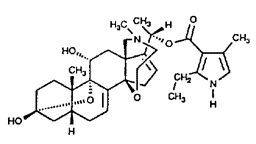 |
Science Frontiers ONLINE No. 85: Jan-Feb 1993 |
|
|
When a bird in the hand is worse than two in the bush
When J. Dumbacher, an ornithologist working in Papua New Guinea, scratched his hand while freeing a hooded pitohui from a collecting net, his first instinct was to suck the wound. This was a bad move, for he immediately experienced a numbing and burning in his mouth. The reason for this, it turned out, was because the skin and feathers of pitohuis are loaded with homobatrachotoxin, a type of poison. This discovery makes the pitohuis the first known poisonous birds. Like many other poisonous animals, the pitohuis also emit a foul odor and advertise their unsavory nature with bright colors. (Dumbacher, John P., et al; "Homobatrachotoxin in the Genus Pitohui: Chemical Defense in Birds?" Science, 258:799, 1992. Also: Anonymous; "Bird with a Sting in Its Tail," New Scientist, p. 10, October 31, 1992.)
 Comment. As we see from the diagram, homobatrachotoxin possesses a rather complex chemical structure. One wonders how the pitohuis acquired the ability to synthesize it through random mutations. The puzzle deepens when one discovers that homobatrachotoxin is also manufactured by the New World poisondart frogs. Although far-separated taxonomically, both species traveled along the same path of random mutations to achieve this evolutionary convergence.
Comment. As we see from the diagram, homobatrachotoxin possesses a rather complex chemical structure. One wonders how the pitohuis acquired the ability to synthesize it through random mutations. The puzzle deepens when one discovers that homobatrachotoxin is also manufactured by the New World poisondart frogs. Although far-separated taxonomically, both species traveled along the same path of random mutations to achieve this evolutionary convergence.